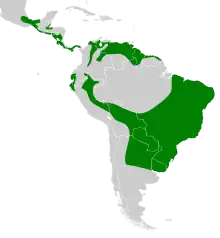Striped owl
The striped owl (Asio clamator) is a medium-sized owl with large ear tufts and a brownish-white facial disk rimmed with black. Its beak is black, and it has cinnamon-colored eyes. It has shorter, rounder wings than most of its close relatives. The upperparts are cinnamon with fine black vermiculation and heavy stripes. The underparts are pale tawny with dusky streaks. It is native to South America and parts of Central America.

| Striped owl | |
|---|---|
 | |
| Scientific classification | |
| Domain: | Eukaryota |
| Kingdom: | Animalia |
| Phylum: | Chordata |
| Clade: | Dinosauria |
| Class: | Aves |
| Order: | Strigiformes |
| Family: | Strigidae |
| Genus: | Asio |
| Species: | A. clamator |
| Binomial name | |
| Asio clamator (Vieillot, 1808) | |
 | |
| Synonyms | |
|
Pseudoscops clamator | |
Taxonomy
The striped owl was formally described by the French ornithologist Louis Jean Pierre Vieillot in 1808 under the binomial name Bubo clamator.[3] The specific epithet clamator is Latin meaning "shouter".[4] The type locality is Cayenne in French Guiana.[5] The striped owl was at one time placed in its own genus Rhinoptynx and was then transferred to the genus Pseudoscops.[5][6] A molecular study that compared mitochondrial DNA sequences indicated that it should be placed in the genus Asio.[7] This result was confirmed by a large molecular phylogenetic study of the owls published in 2019.[8][9]
Description
The striped owl is a relatively large species with prominent tufts of elongated feathers on the crown resembling ears. It is 30–38 cm (12–15 in) long and weighs from 320 to 546 g (11.3 to 19.3 oz).[10] Its head, back, hot wings and tail are brown with black stripes and small markings while its underparts are buff-coloured with heavy black streaking on the breast. The facial disk is pure white with a thin black border.[11]
Distribution and habitat
The striped owl is native to much of South and Central America. Its range is not well known, perhaps because it is nocturnal and not easily seen, but it is known from Argentina, Belize, Bolivia, Brazil, Colombia, Costa Rica, Ecuador, El Salvador, French Guiana, Guatemala, Guyana, Honduras, Mexico, Nicaragua, Panama, Paraguay, Peru, Suriname, Trinidad and Tobago, Uruguay and Venezuela. It uses a variety of habitats, including riparian woodlands, marshes, savannahs, grassy open areas, and tropical rainforests. It can be found from sea level to an altitude of 1,600 m (5,200 ft) and above.[1]
Conservation status
The striped owl has a very large range and its population is believed to be stable. It faces no particular threats and is classified by the IUCN as least concern.[1]
References
- BirdLife International (2016). "Asio clamator". IUCN Red List of Threatened Species. 2016: e.T22689522A93234205. doi:10.2305/IUCN.UK.2016-3.RLTS.T22689522A93234205.en. Retrieved 12 November 2021.
- "Appendices | CITES". cites.org. Retrieved 2022-01-14.
- Vieillot, Louis Jean Pierre (1807). Histoire naturelle des oiseaux de l'Amérique Septentrionale : contenant un grand nombre d'espèces décrites ou figurées pour la première fois (in French). Vol. 1. Paris: Chez Desray. p. 52, Plate 20. Although the title page bears the year 1807, the volume was not publish until 1808. See: Dickinson, E.C.; Overstreet, L.K.; Dowsett, R.J.; Bruce, M.D. (2011). Priority! The Dating of Scientific Names in Ornithology: a Directory to the literature and its reviewers. Northampton, UK: Aves Press. p. 157. ISBN 978-0-9568611-1-5.
- Jobling, James A. (2010). The Helm Dictionary of Scientific Bird Names. London: Christopher Helm. p. 110. ISBN 978-1-4081-2501-4.
- Peters, James Lee, ed. (1940). Check-List of Birds of the World. Vol. 4. Cambridge, Massachusetts: Harvard University Press. p. 166.
- Dickinson, E.C.; Christidis, L., eds. (2014). The Howard & Moore Complete Checklist of the Birds of the World. Vol. 2: Passerines (4th ed.). Eastbourne, UK: Aves Press. p. 268 Note 11. ISBN 978-0-9568611-2-2.
- Wink, M., A. A. El-Sayed, H. Sauer-Gurth, & J. Gonzalez. 2009. Molecular phylogeny of owls (Strigiformes) inferred from DNA sequences of the mitochondrial cytochrome b and the nuclear RAG-1 gene. Ardea 97(4):581-591.
- Salter, J.F.; Oliveros, C.H.; Hosner, P.A.; Manthey, J.D.; Robbins, M.B.; Moyle, R.G.; Brumfield, R.T.; Faircloth, B.C. (2019). "Extensive paraphyly in the typical owl family (Strigidae)". The Auk. 137 (ukz070). doi:10.1093/auk/ukz070.
- Gill, Frank; Donsker, David; Rasmussen, Pamela, eds. (January 2021). "Owls". IOC World Bird List Version 11.1. International Ornithologists' Union. Retrieved 17 May 2021.
- Owl pages (2011).
- Thurber, Walter A.; Rebecca Lohnes & Thomas S. Schulenberg (2009). "Pseudoscops clamator: Striped Owl". Neotropical Birds Online. Cornell Lab of Ornithology. Retrieved 2013-12-22.
External links
- Striped Owl videos on the Internet Bird Collection
- Stamps (for Suriname) with RangeMap
- Photo-Medium Res; Article borderland-tours
- Striped Owl photo gallery VIREO
